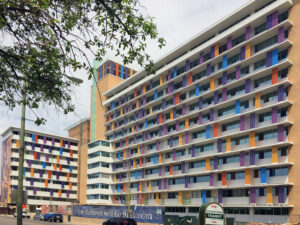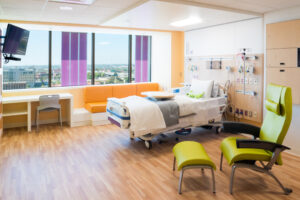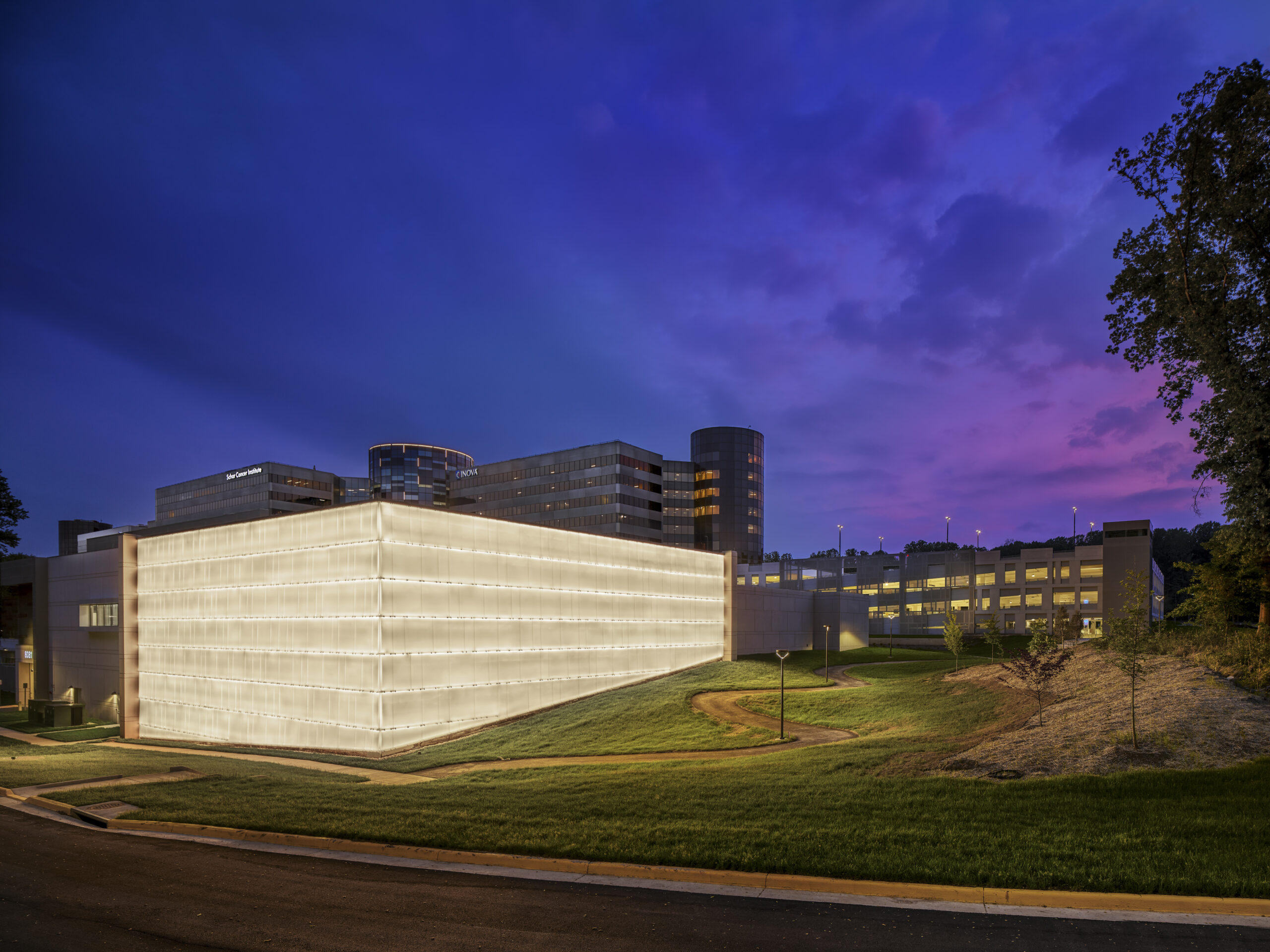Photo: A glass rainscreen system at Inova Schar Cancer Institute in Virginia serves aesthetic and functional purposes. | Photo Credit: Halkin Mason Photography
By Steven Jayson
In any hospital, the materials speak before the staff does.
In healthcare environments, materials aren’t neutral, they carry emotional weight. For patients and families in vulnerable moments, and for the nurses and staff who return each day, these design decisions affect them. Every material choice is a quiet contributor to the healing environment.
That’s why, when talking about healthcare design, designers shouldn’t just ask what is being built but should ask how it makes people feel.
Glass, often seen as cold or clinical, can change the emotional tone of a space. Examples abound of how something as simple as a glass panel can shape that emotional experience. In the hands of a thoughtful design team, glass becomes a tool for bringing in light, for connecting people with nature and for creating a sense of calm that can’t be prescribed.
Design for Emotional Well-Being

Photo Credit: Courtesy of Bendheim
In today’s healthcare architecture, aesthetic appeal isn’t enough. The most successful places are the ones that enhance emotional well-being for patients, for families and for staff. That means thinking beyond functionality and asking how materials like glass interact with color and light.
Glass bends light, shifting color and intensity throughout the day. It breathes life into a space. Views of the outdoors, especially those with a strong proportion of sky, trees and open green spaces, have measurable effects on mental health. According to GSP Health, exposure to daylight improves mood, cognitive function and even immune response. But the key is access: Not every room can have a window, and not every corridor can open to the outside. That is where interior glass becomes valuable. It channels light deep into the building and preserves visual privacy.
It’s always important to think about staff. They spend the bulk of their lives inside these environments. If the space doesn’t support their mental health, it’s not just a missed opportunity, it’s a liability. The Patient Safety and Quality Handbook for Nurses suggests that a better-designed work environment includes access to natural light and thoughtful noise reduction to minimize fatigue. Happier and less stressed employees are less likely to make mistakes.
When designing spaces that offer comfort, it’s not just making them more livable, it’s making them more healing, and extends that same care to families because well-being doesn’t stop with the patient. When families feel more grounded, it takes the tension out of the air and that ripple effect benefits everyone in the room, including the patient.
At the Children’s Hospital of San Antonio for example, Bendheim’s channel glass façade not only brings vibrancy through color, but also fills the interior with natural light. The translucent glass, visible from within the rooms, adds a playful spirit to the space.
Glass as a Bridge to Nature

Photo Credit: Courtesy of The Children’s Hospital of San Antonio
One of the most powerful opportunities in healthcare design is to reconnect people to the natural world. The outside world is medicine for the mind and body. A window that frames a tree, the sky or even a distant horizon provides more than a view. It offers a connection to nature, a vital antidote to stress. According to Frontiers in Psychology, increasing accessibility to nature can yield both immediate and long-term benefits to mental health.
But nature doesn’t always mean a courtyard or a window. A well-placed wall of glass can draw the outside in, even in deep interior zones. Digitally printed glass, with an image of autumn leaves or a forest canopy can offer a sense of place and seasonality, with privacy where it’s needed.
It’s about connection, not exposure, and the beauty of glass is it can offer both. Houdini™ Glass, for example, lets light pass through while obscuring the person behind it. By incorporating Ultra-White Fade® Laminated Glass into partitions at NYU Langone Medical Center, the design team crafted spaces that provided privacy without sacrificing natural light or access to external views. When people can’t get outside, it’s possible to bring the outside to them.
Sustainability Meets Functionality
The future of healthcare design is increasingly tied to sustainability, especially as healthcare facilities remain energy intensive. When thoughtfully designed, glass offers more than aesthetic beauty, it improves performance.
Glass rainscreen systems, like those used at the Inova Schar Cancer Institute, serve both aesthetic and functional purposes. In this case, the luminous, shingled glass rainscreen transforms the façade into a sculptural surface that glows at night, illuminating the grounds and serving as a soft, welcoming beacon.
Glass systems like Z-KISS™ and TurnKey™ offer a cost-effective alternative to traditional construction methods. Designed for fast and easy installation, they help accelerate construction schedules and reduce overall project costs. These systems also deliver long-term flexibility, enabling spaces to be quickly reconfigured or rebranded without costly demolition or extended downtime. Panels can be removed and replaced with minimal disruption, allowing easy access behind the wall and reducing future maintenance expenses.
Glass’ durability, ease of cleaning and minimal maintenance make it a smart long-term investment. Bendheim products are made with up to 60% recycled material and backed by third-party verified Health Product Declarations (HPDs) and Environmental Product Declarations (EPDs).
The Future is Luminous
As we look to the future, glass will continue to play a pivotal role in shaping healthcare environments. Larger glass panels, designs focused on circadian rhythms and more intentional uses of natural light will transform hospitals and care centers into sanctuaries.
These ambitious goals require more than just providing high-quality materials. A collaborative design-assist approach helps make informed decisions every step of the way. With thoughtful collaboration, it’s possible to push the boundaries of healthcare design, one space at a time.
Steven Jayson is a partner at Bendheim, a New Jersey-based provider of architectural glass systems and solutions.


